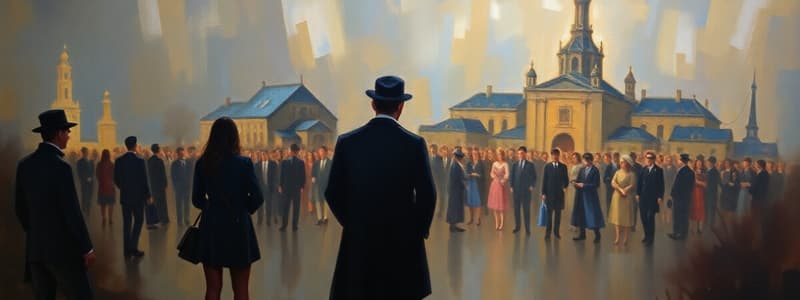Podcast
Questions and Answers
What primarily distinguishes criminal behavior from other forms of social deviance?
What primarily distinguishes criminal behavior from other forms of social deviance?
- The public's perception of the behavior
- The individual's intention behind the behavior
- The social and political context surrounding the behavior (correct)
- The inherent attributes of the behavior itself
Which of the following concepts is most associated with the view that laws are a result of social conflict?
Which of the following concepts is most associated with the view that laws are a result of social conflict?
- Social consensus
- Moral regulation
- Critical sociology
- Conflict theory (correct)
Which of the following best describes moral entrepreneurs in the context of social regulation?
Which of the following best describes moral entrepreneurs in the context of social regulation?
- People opposing regulations to increase individual freedoms
- Entities that seek to abolish existing laws regardless of moral implications
- Individuals who promote deviance as a way to challenge laws
- Groups that create and enforce moral standards within society (correct)
What role do social institutions play in the context of Foucault's ideas on moral regulation?
What role do social institutions play in the context of Foucault's ideas on moral regulation?
What is a key characteristic of behaviors that are classified as crimes under critical definitions?
What is a key characteristic of behaviors that are classified as crimes under critical definitions?
What does the term 'moral panic' refer to in the context of crime and societal reaction?
What does the term 'moral panic' refer to in the context of crime and societal reaction?
How does mass media typically influence public perception of crime?
How does mass media typically influence public perception of crime?
Which of the following best describes the objectivist-legalistic approach to defining crime?
Which of the following best describes the objectivist-legalistic approach to defining crime?
In what way can crime be perceived as a product of political processes?
In what way can crime be perceived as a product of political processes?
What role do social reactions to crime play in shaping public fear?
What role do social reactions to crime play in shaping public fear?
What role do mass media accounts play in shaping public perception of crime?
What role do mass media accounts play in shaping public perception of crime?
What is a common misconception perpetuated by media portrayals of crime?
What is a common misconception perpetuated by media portrayals of crime?
According to research, how does the portrayal of crime in the media differ from official definitions?
According to research, how does the portrayal of crime in the media differ from official definitions?
What factor may increase public calls for government intervention regarding crime, according to media portrayals?
What factor may increase public calls for government intervention regarding crime, according to media portrayals?
How might media coverage contribute to crime according to the content?
How might media coverage contribute to crime according to the content?
What did Stanley Cohen's research focus on regarding media and crime in the late 1960s?
What did Stanley Cohen's research focus on regarding media and crime in the late 1960s?
What is one consequence of media misrepresentation of crime?
What is one consequence of media misrepresentation of crime?
How has the shift from traditional mass media to new media impacted crime awareness?
How has the shift from traditional mass media to new media impacted crime awareness?
Flashcards
Deviance vs. Crime
Deviance vs. Crime
Deviance refers to behaviors that violate social norms, while crime involves violations of laws.
Conflict Criminology
Conflict Criminology
A perspective that examines law-making as a result of conflict between different societal groups.
Moral Regulation
Moral Regulation
The control of behavior based on moral standards rather than social consensus.
Moral Entrepreneurs
Moral Entrepreneurs
Signup and view all the flashcards
Critical Definitions of Crime
Critical Definitions of Crime
Signup and view all the flashcards
Rhetorical Communication
Rhetorical Communication
Signup and view all the flashcards
Media Portrayals of Crime
Media Portrayals of Crime
Signup and view all the flashcards
Public Perception of Crime
Public Perception of Crime
Signup and view all the flashcards
Fear of Crime vs. Risk of Victimization
Fear of Crime vs. Risk of Victimization
Signup and view all the flashcards
Sympathetic Victims
Sympathetic Victims
Signup and view all the flashcards
Influence of Media on Crime Awareness
Influence of Media on Crime Awareness
Signup and view all the flashcards
Moral Panics
Moral Panics
Signup and view all the flashcards
Social Media's Impact on Crime Awareness
Social Media's Impact on Crime Awareness
Signup and view all the flashcards
Criminology
Criminology
Signup and view all the flashcards
Objectivist-legalistic approach
Objectivist-legalistic approach
Signup and view all the flashcards
Social-reaction approach
Social-reaction approach
Signup and view all the flashcards
Fear of crime
Fear of crime
Signup and view all the flashcards
Study Notes
Criminology
- Criminology is the body of knowledge about crime as a social phenomenon.
- It encompasses the creation of laws, the breaking of laws, and the reactions to law-breaking.
- Sutherland and Cressey (1960) defined it as the body of knowledge.
Chapter 1: Crime, Fear, and Risk
- This chapter discusses crime, fear, and risk within a Canadian context.
Learning Objectives
- Understand objectivist-legalistic and social-reaction approaches to defining crime.
- Grasp critical concepts related to Canadian criminal law and the justice system.
- Outline media portrayals of crime.
- Recognize the relationship between public fear of crime and media depictions.
- Examine the laws as political outcomes.
- Understand moral panics and provide examples.
- Critically assess the moral panic framework.
Introduction
- Defining crime involves different perspectives.
- Two primary approaches are objectivist-legalistic and social-reaction.
What is a Crime?
- Historically, harmful behavior was viewed as a private matter.
- Over time, certain harmful acts became criminalized as harms against society as a whole.
- The state now enforces and prosecutes these acts.
1) Objectivist-Legalistic Approach
- Laws reflect widely shared customs and codified beliefs.
- Crime is defined as any action against the law.
- Criminality is restricted to legal definitions.
- Criminologists analyze where behavior violates criminal law and identify the causes of criminal acts.
1) Objectivist-Legalistic Approach, cont'd
- This approach assumes criminal law mirrors societal agreement on right and wrong, labeling violators as deviant.
- It guides theories focusing on factors like biology, psychology, and sociology to explain offending behavior.
What is a Crime? (Legal Definition)
- Legally, crime is conduct prohibited by law and subject to penal sanctions, targeting public harm or societal injury.
- In Canada, these prohibitions arise from intensely political legislative processes.
- Enforcers (police and judiciary) must apply laws without personal bias.
The Legal Definition of Crime
- The Criminal Code defines crimes in Canada.
- A specific online link was provided for accessing Canada's Criminal Code.
Criminal Justice in Canada
- Canadian criminal law stems from the Criminal Code of Canada.
- Three broad categories of crimes exist:
- Crimes against persons (e.g., murder, sexual assault).
- Property crimes (e.g., theft, breaking and entering).
- Offenses without obvious victims (e.g., illegal drug use, prostitution). These can be categorized as public order crimes or victimless crimes.
Federal Legislation and Criminal Law
- Federal acts such as the Youth Criminal Justice Act, the Controlled Drugs and Substances Act, and Customs and Excise Act are relevant to criminal law.
Criminal Justice in Canada, cont'd
- Canada's justice system largely follows the objectivist-legalistic approach.
- Criminal law is part of a broader legal framework including administrative, civil, and regulatory laws.
Criminal Justice in Canada, cont'd (Administrative and Civil Law)
- Administrative law governs state-individual relationships (e.g., employment insurance, landlord-tenant relations).
- Civil law concerns disputes and agreements between individuals (e.g., property disagreements, contracts).
Federal and Provincial Regulatory Legislation: Quasi-Criminal Law
- Criminal law addresses inherently wrongful behaviors (e.g., public harm).
- Regulatory offenses, less serious, may not result in criminal records.
- These offenses do not require proving guilt "beyond a reasonable doubt."
- They're often referred to as 'quasi-criminal.'
2) Crime and Social Reaction
- Labelling theory, developed by Howard Becker, analyzes how societies define and respond to deviant behaviors.
- Crime definitions should be broader.
- Law isn't a reflection of societal consensus.
- Societal consensus on deviancy is absent.
Crime and Social Reaction, cont'd (Howard Becker)
- No act is fundamentally deviant or criminal intrinsically.
- Social groups create deviance by applying rules to behaviors.
- Deviance and crime are social constructs, defined by those in power.
- The label "deviant" is a social response to behavior.
Crime and Social Reaction, cont'd (Social Constructionism)
- Social constructionism explores how and why certain problems (e.g., crime) are defined and addressed.
- The meaning of deviance and crime varies across cultures.
- No universal acts are universally condemned.
- Crime is socially constructed, not an objective reality.
- Harm doesn't always predict societal deviance or crime.
Crime and Social Reaction, cont'd (Deviance)
- Sociologists study deviance by analyzing various rule-breaking behaviors, actions, conditions, and individuals and the responses to them (e.g., exclusion, shaming, imprisonment).
Crime and Social Reaction, cont'd (Conflict and Critical Criminology)
- Conflict criminology examines the power dynamics in lawmaking and criminalization.
- It views society as a conflict zone between groups (e.g., bourgeoisie and proletariat).
- Critical criminology looks at power imbalances based on social class, race, and gender.
Crime and Social Reaction, cont'd (Moral Regulation and Moral Entrepreneurs)
- Moral regulation (Foucault) explains social discipline and self-regulation through moral principles, not societal consensus.
- "Moral entrepreneurs" (Becker) are those who influence public perception and motivate and create new rules.
Media Portrayals of Crime in Canada
- Media significantly shapes public understanding of crime.
- Media often overemphasizes danger and violence.
- Victims are often sympathetically portrayed.
- Justice systems are sometimes portrayed as soft on criminals, and the emphasis on fear may lead to overestimation of risk or calls for stricter laws.
Media Portrayals of Crime, cont'd
- Public knowledge of crime is heavily sourced from mass media.
- Mass media portrayal of crime contrasts with official measurements and definitions.
- Decreasing consumption of traditional media is countered by increased use of social media, alongside concerns about measuring its influence on public awareness.
Fear
- Anti-SOGI protests and misinformation have raised concerns about social divides, public perceptions, and the potential use of moral panics.
Crime and Moral Panics
- Stanley Cohen examined moral panics related to crime, societal values, and media portrayals.
- Moral panic is a societal response to a perceived threat.
- Media can promote inaccurate crime perceptions, and politicians may utilize these to advance particular agendas or law-and-order policies.
Criticisms of the Moral Panic Perspective
- Some find limitations in the moral panic approach, often questioning its efficacy or impact on actual crime reduction.
Criminal Justice in Canada, cont'd (Offence Types and Plea Bargaining)
- Two main categories exist: summary and indictable offences.
- Summary offenses are less serious than indictable ones.
- Plea bargaining is a prevalent process in which the accused negotiates with authorities, often avoiding trials.
Criminal Justice in Canada, cont'd (First Contact and Accused Rights)
- The criminal justice system's first point of contact for individuals is often with the police.
- Police arrest individuals, with or without warrants, and typically charge them.
- The accused may or may not be taken into custody, with bail proceedings determining whether the accused is released or remains in detention.
Criminal Justice in Canada, cont'd (Indigenous Legal Traditions)
- Indigenous legal traditions predate European colonization, and they are based on different customs, traditions, and practices.
- They differ from those of Western legal systems, potentially involving oral transmission rather than written codes.
- Elders and cultural ceremonies were important in these systems.
Studying That Suits You
Use AI to generate personalized quizzes and flashcards to suit your learning preferences.




